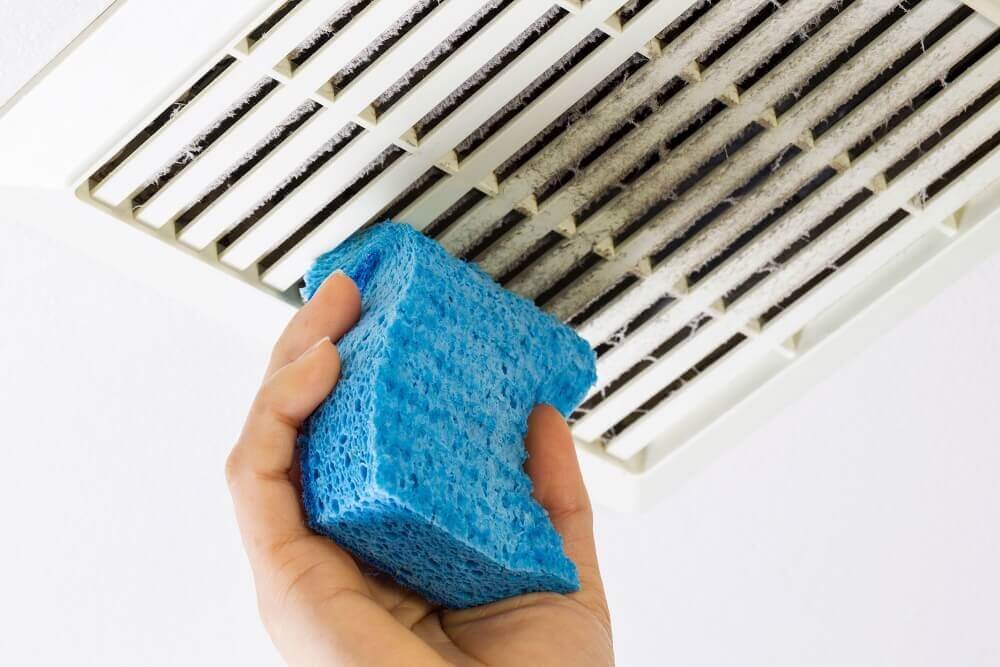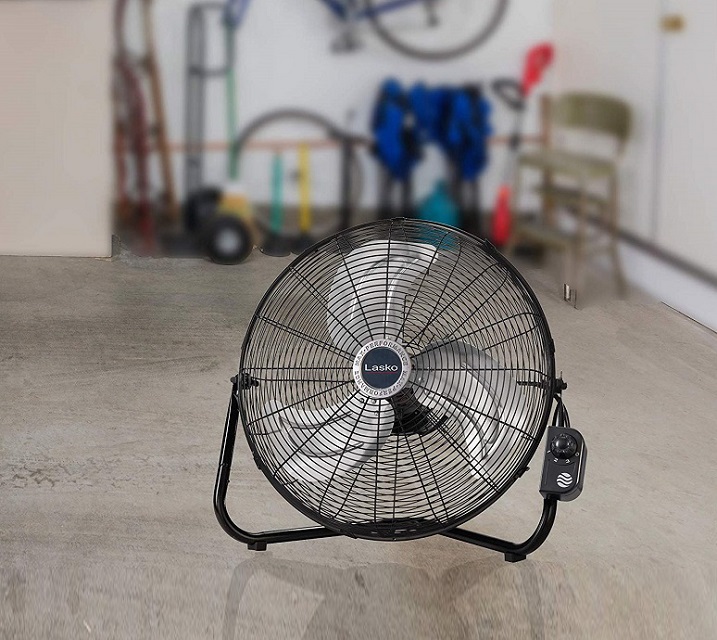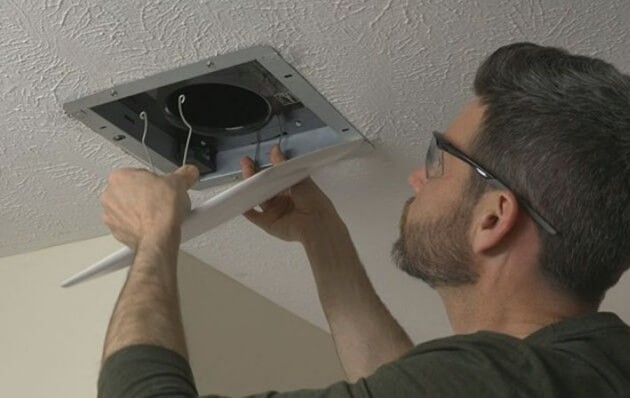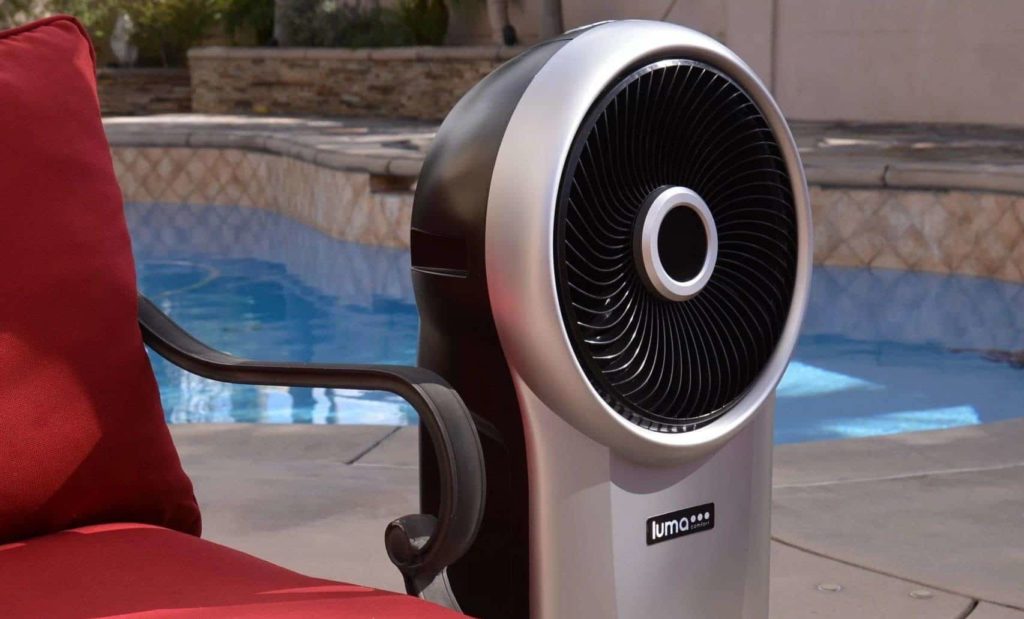

A ceiling fan with remote that is perfect for the room décor, size, and design is not impossible to find if you know what you are looking for. Unfortunately, a lot of people pick their ceiling fans based on very few considerations, which can lead to regrets later on.
The comprehensive list of things to look at when choosing the best ceiling fans with remote for your needs includes size, blades, airflow, weight, construction materials, number of speeds, and extra features. The size of the fan affects the installation of the tool. Other features that affect installation are the weight and construction of the fan. For the latter, it will also influence longevity and lifespan. The blades and airflow available show you how useful the tool can be in cooling your home. The last feature is the number of speeds you get to know by how much you can tweak the cooling output of the device. With these features accounted for, our Editor’s Choice is the Hunter Sentinel.
Other features: handheld remote control and wall-mounted cradle, downrod mounting, LED bulb, indoor use only
If your ceiling is 9-11 feet high, we highly recommend the GE 20314 l Indoor LED Ceiling Fan as your purchase. The fan comes with a set of LED bulbs so that it can take a central role in any room, offering both improved air circulation and lighting.
A white glass case covers the LED bulbs, but it also multipurpose. Its other use is to spread the light evenly around the room.
After receiving the package, you should take out the downrods first. These are accessories that will help with installation ensuring optimum distance from the ceiling. Of course, you should know that less than optimal placement of the fan would inhibit proper air movement.
The three fan blades included are made of metals, as is most of the fan body. However, for a lot of the finish options available, the fan blades end up looking like they are made of plywood.
Of course, since this list is about ceiling fans with remotes, this tool has to come with one of its own. With this, you can select which fan speed to use depending on the heat in the house.
The remote allows you to adjust bulb brightness as well. Another accessory is the wall-mounted cradle. This component can be used for the storage of the remote. Noteworthy is that reverse rotation is also available for use in the winter.
Other features: protruding mounting, 13.5” min hanging height, handheld remote, supplies with 6” downrods
The Minka-Aire F843-DK Ceiling Fan is seemingly the only fan on the list without a light. Notwithstanding, it is still one of the most beautiful options you can have in your home. It is also functionally excellent.
This product consists of three blades made of steel, contrary to how it looks. Nevertheless, the distressed koa finish is exciting.
Additionally, the product comes with 6” downrods. However, there are six other downrods available that would cater to different ceiling heights. The longest downrod is 60” while the shortest one is 3.5”.
For more functionality, you are allowed to purchase the BD-1000 smart device. This would allow you to incorporate Wi-Fi functionality into your fan. Also, you would need to install the bond app on your smartphone. Remember, you can even use voice-activated fan features once you have done this.
If you feel like using Wi-Fi is too much of a hassle, the handheld remote control is always available. You can control the fan and switch between the fan speeds as you see fit.
A disclaimer is that the fan may be noisy in the first 48 hours of use. This is expected since oil isn’t well distributed in the motor. However, after that, the noise is expected to subside.
Other features: Smart Sync’, light dimmer, lifetime warranty, quiet reversible motor
If you have Alexa in your home, you may want to purchase the Honeywell Carmel 48-Inch Ceiling Fan since it is compatible with the app. Also, this tool and the GE 20314 l Indoor LED Ceiling Fan are the only two listed with five fan blades.
Remember that you can use either Alexa or the included remote to control speeds and to dim the lights. However, for you to use Alexa, you also have to make an extra purchase in the form of a “bond hub.”
Despite the fan being smaller as compared to other options, the device can be used in medium to large rooms in your house. As you can see, a white glass casing is visible in the middle of the fan. It houses three 40-watt bulbs that can be dimmed if need be.
Also, for those wondering about the warranty, you are given a limited one that should last you your whole life. On top of that, the device is quiet, and you can put the fan in reverse mode.
Remember, the reverse mode is best used in winter so that the warm air can be spread to all parts of the room.
Other features: reversible switch, opal frosted glass light kit, lifetime motor warranty
As for the smallest house accessory to feature on the list, you get the Westinghouse Lighting 7876400 LED Ceiling Fan. The product is 42” and combines both a light and a fan into one device. It also won’t be too much of a strain for your ceiling since it only weighs 10 lbs.
However, owing to its small size, it isn’t the best option for large rooms. Also, three is the number of fan blades on this device and is also the number of fan speeds available.
Activating the fan reverse mode on the fan blades is not a complicated matter as well since you just flip a switch. As for the light, you get a non-LED and an LED option at varying prices. Whatever option you choose, you still get a lifetime motor warranty.
Other features: reversible fan blades, LED light source, handheld remote control, flush mount
Opting for the GE 20314 l Indoor LED Ceiling Fan is also another choice you can make as a buyer. The product is 52” in size, similar to the editor’s choice.
As you can see, the finishing and design are quite different. This is visible in the number of fan blades as well as construction. The rule is that with a higher number of fan blades, you will get a quiet device. The air circulation may also be significantly reduced.
Even with that being the general rule, other aspects of the design and construction of this tool may affect the air circulation for the better. Plywood, glass, and steel are the main components of the room cooling tool.
The plywood is used to make the fan blades while the steel covers the mechanical and electric parts of the product. Lastly, glass is used to cover the LED light source.
The LED lights in this fan can live out a 25,000-hour life, so the product should be useful for a couple of years to come.
As expected of the purchase, a remote control is provided. With it, you can toggle between the three fan speeds and dim or brighten the light if necessary. Another thing in your control is whether you will get an updraft or downdraft of air by choosing between forward motion and reverse.
Lastly, you can relax in the knowledge that a limited lifetime guarantee is there for the motor of this device.
Even if you are not a first-time buyer of ceiling fans with remote, you can still make a mistake and get a product that isn’t at all in tune with your needs. This is typically followed by frustration and sometimes loss of money. The best possible outcome involves buying a fan that you would buy again and again if you were to find yourself in such circumstances. This guide should allow you the luxury of buying the best ceiling fan with a remote without too much of a struggle.
Very few people will buy the ceiling fan solely for its decorative attributes. There are a few other benefits that most people are looking for, which include a cooler room. The device blows away the hot air around you, and all you can feel as a result is a cool breeze.
Of course, the effect of a cooler room can also be achieved using a conventional HVAC system. However, the difference is that a HVAC system will consume much more energy from your home. Therefore, by using a ceiling fan instead, you get to cut down on some of your utility bills and can save more money as a result.
Remember that some offer reverse fan motion as well. This makes them usable in the winter as well. They will work to distribute the heat in the room more evenly without needing the HVAC.
Buyers of ceiling fans will love how the devices don’t require maintenance. Cleaning them is easy. Also, you may need to change bulbs as well as check the integrity of the fastening screws once in a while.
Another thing you would note with these tools is they are simply designed and thus easy to install.
It is no secret that some of you look at a list of ceiling fan features and get even more confused. How, would you know what a downrod is and how it affects your installation? The truth is you may not know about the mentioned features, and that may present a problem in your purchase process.
However, eliminating this problem is easy. You just read the section below. When you finish, you will know all about ceiling fan jargon. Also, you will know what benefits come by as a result of the inclusion of certain features.
Admittedly there is only one style of ceiling fan with remote shown above, and that is the hanging propeller option. Often when such a fan is installed, it is put there to serve the needs of the whole room. The name suggests a similar design to that of a plane propeller.
Nevertheless, the propeller hangs from the ceiling of your house. Another style is the directional ceiling fan. Directional ceiling fans can be controlled as to the specific spots in the room where they need to focus blowing air hence the name. You may even have directional devices that incorporate more than one fan in the machine.
In some cases, you can use a remote to alter the direction of airflow, while in others, you will need manual input. Lastly, there are rotational style fans whose blades are capable of spinning independently. Multiple sets of blades are another characteristic that they may possess.
Paying attention to the mounting type is something smart fan shoppers do. The common ones are hugger ceiling fans, close-to-ceiling/low profile ceiling fans, ceiling fans with downrods and ceiling fans on sloped ceilings.
A hugger ceiling fan is a popular pick for people with low ceilings. The flush mounting means zero clearance to the ceiling. They are also known as flush-mount ceiling fans. You can look at the image of the GE 20314 l Indoor LED Ceiling Fan for an example of the same.
Ceiling fans with downrods allow for the accessory to have certain levels of clearance from the ceiling. The downrod is a pipe that connects the mounting hardware attached to the ceiling to the central part of the fan, which includes the fan blades and the motor.
A downrod can be quite long, depending on your needs. This is apparent in the case of the Minka-Aire F843-DK Ceiling Fan, which has an optional downrod with a reach of 60”. Close-to-ceiling fans may also have shorter downrods.
If you were to pick the 3.5” downrod for the Minka-Aire F843-DK Ceiling Fan, it would be a low profile ceiling as well. Lastly, you have ceiling fans that work for sloped ceilings. As you would expect, they have to cater to the slope by incorporating more clearance. This prevents the ceiling from coming into contact with the fan blades.
Whether you want to install the ceiling fan with remote inside or outside alongside where you live will also heavily influence the fan you pick. The dry fans work where there is zero contact with moisture. Moreover, heat can sometimes be detrimental to them, as well.
Manufacturers advise that you only use these models indoors and in areas of the house where humidity is low. The Hunter 59211Sentinel Ceiling Fan is a prime example of dry-rated fans.
Damp fans can handle the occasional encounter with moisture. Thus, being in a bathroom shouldn’t be a problem. Humidity won’t be detrimental to them either. If, however, you expose them to rain or snow, you may have a problem.
Wet-rated fans are the best suited for outdoor areas. Rain or snow and high humidity levels will not affect the lifespan of the fan.
Remember that size of the fan blades is going to affect the airflow. As such, accounting for the size of the fan alongside the size of your room is essential. The 42” Westinghouse Lighting 7876400 LED Ceiling Fan may, for instance, be good enough for small rooms. Nonetheless, it won’t be able to service the needs of larger rooms. You need a larger option, such as the 52” Minka-Aire F843-DK Ceiling Fan for that.
CFM ratings are as well displayed for almost all fans you come across. You can tell the volume of air the fan can move by looking at the CFM rating. Additionally, there are ideal CFM ratings for different room sizes. This necessitates that you check both your room size and correlate that to the cubic feet per minute rating of a prospective fan purchase. With this, you are sure you get adequate ventilation from the fan.
If you want more air circulation from fans of the same size, you are better off choosing options with fewer blades. There isn’t as much drag when the blades are minimal; hence the fan can rotate faster, leading to more airflow. Adding more blades, of course, has the opposite effect.
Handheld remotes are popular since you can use them from anywhere. However, they also get misplaced a lot, and that can leave you in a bind. With wall control, you don’t need to worry about losing remotes since the controls remain in the same position.
Even better is a handheld remote and wall control combo. Using a smartphone application with ceiling fans is also possible with products like the Honeywell Carmel 48-Inch Ceiling Fan. Since people carry their smartphones/phablets everywhere, they will always have control of the fan.
Drag is a common phenomenon where the spinning of the blades is concerned. Of course, it is caused by the friction between the air and the fan blades. If the fan blades aren’t strong enough, they would be broken or be bent by the pressure exerted.
Similarly, the product is likely to have a short lifespan if the materials used to make it are inferior in quality. The Minka-Aire F843-DK Ceiling Fan is made solely out of steel; hence it wouldn’t be surprising for it to last more than a few years.
Some ceiling fans come with a light and a remote with the example of the Honeywell Carmel 48-Inch Ceiling Fan. The incorporation of lights could work to your advantage, especially if your fan is installed in a central position.
That being said, even the quality of the light can affect your experience. The incorporation of LEDs is often preferred, given their long lifespans and energy efficiency. The minimal heat produced may also be easily swept away by the motion of the fan.
Remember that not all ceiling fans come with lights. If the prospective purchase doesn’t, do you have a plan to cater for lighting? Will the lights you already have posed a problem for the installation? For better results, answer these questions before deciding to pick option A or B on from the ceiling fan options you want to buy.
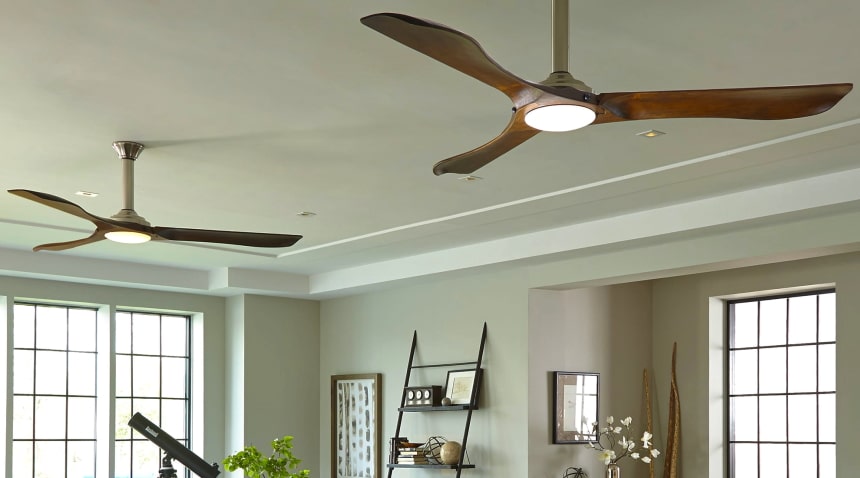
There is no doubt that buyers are trying to cut down on costs by using a fan instead of the usual HVAC system. However, how much energy you save also matters. Some will use up more energy to power the motors. Of course, those with lights in their designs also need to power them. Remember that minimal energy use is ideal as you compare the benefits of different ceiling fans.
A fan with an audible motor being installed in the bedroom would make it impossible to sleep for some. In other rooms, in the house, the hum produced may be downright annoying. A quiet fan is best. You get all the benefits without any annoying noises.
Also, getting a fan that breaks down within a month of use wouldn’t do you any good. Worse is if a warranty does not cover you for repairs. In cases like this, you regret the purchase, and that might even put you off from buying another ceiling fan.
Someone else would get a replacement or their fan repaired for free by the manufacturer. For this reason, a lot of people look for warranties in most of their purchases. They also pay attention to the wording of these guarantees to know what components of their investment are covered. You should do something similar while selecting a fan.
Alternatively, removing the receiver is another option. However, you may need to hook the product to the house wiring. This will allow for manual operation where you can use the fan with a pull chain.
Our third favorite ceiling fan is the Honeywell Carmel 48-Inch Ceiling Fan, which is a smart sync fan. It is compatible with Alexa and can be used in medium and large rooms despite its compact size.
An alternative to that design is present in the Minka-Aire F843-DK Ceiling Fan, which is our third favorite option. The construction of the fan and the installation options also make it top-notch.
Our highest-rated ceiling fan is the Hunter 59211Sentinel Ceiling Fan. It is durably made, easy to control, and even provides a cradle for you to keep the remote. Having a reverse mode is a huge plus as well. Remember that on the list above, there are options for various budgets and needs. You can’t go wrong with your pick if you have been taking in the information we have availed above.
